Autores: Hervé Pennec
Ano: 2022
ISBN: 978-989-781-718-2
The context of the research journey that has led to the present book is a body of work of mainly 16thand 17thcentury textual documents concerning a mission of the Society of Jesus that began in Ethiopia in 1555 and ended in 1633, when their last members were expelled from the country. Throughout its duration and afterwards, up to the 18thcentury, the mission was the subject of an extended set of scriptural, archival and literary documents, produced by the Jesuits themselves and others. Sources include contemporary Iberianroyal and governmental authorities in India, writings in Ge’ez (Ethiopia’s classical liturgical language) and works of local scholars, royal chronicles and hagiographical sources, etc. Most of these documents are well known today and regularly feed a rich field of research on that period of Ethiopian history. However, despite the fact that the presence of the mission in Ethiopia has been carefully studied, there has still been little research on the mission’s own production of written material, based on those sources and their history. And this too requires critical attention.
Indeed, it was between the end of the 19thcentury and the beginning of the 20thcentury that this vast wealth of documental production underwent scholarly treatment in European academic and ecclesiastic circles. Great effort went into collating, compiling an inventory and editing the many hitherto unpublished documents of both European and Ethiopian origin. Understanding the context of this effort and the methods of appropriation in comparison to previous attempts to do so, which are distant both in time and space, is the subject of the present book. Although it is still concerned with the same general field as my previous book, Des Jésuites au Royaume du prêtre Jean (Éthiopie). Stratégies, rencontres et tentatives d’implantation (1495-1633), my goal on this occasion is considerably different. While the first book focussed specifically on the history of the mission itself, the present work is centred on the process of creating an authoritative body of “scholarly” documental work at the end of the 19thcentury; i.e. I examine how it was “fabricated” by identifying the main agents, the collating and cataloguing methods used, the stakes involved and the motives for their selection.
This has meant redirecting my research towards retracing the steps these scholars took to build a corpus of “primary sources” and towards questioning the specific historical context in which images and forms of knowledge were produced in a number of European countries in various publications dedicated to Ethiopia, to the history of Portuguese-Ethiopian relations and to the Jesuit mission in the country of the source of the Blue Nile. Above all, the present effort aims to debunk the a priorijudgement of scientific neutrality of building up documental corpuses disregarding the ideological context of late 19th-early 20thcentury Europe.
My intention here is thus an attempt to historicise these materials, in order toquestion what they meant for their contemporary public and how they related to the social worlds that gave them meaning. The starting question for my research was how and in what way was the erudite production of the fin de siècleable to shape and condition knowledge about a specific African region in the modern period. The approach I adopted was to consider knowledge as the object and the challenge of operations, processes and negotiations; i.e., by approaching knowledge not so much as information content but rather as an object in the making, taking into account its social dimensions. The priority was thus to study the social production itself, as if I were arranging the movements of the different protagonists on a stage, looking at the details, the objects and the actors’ comments on what they were doing. Hence the attention given to the dialogue between the different types of sources (be they direct or indirect, material, figurative or written).
My inquiry lies at the crossroads of several historiographies. On the one hand, the history of Christian missions: missions of the modern era, but not exclusively so, because the research topic leads to questions about the historiography of the Jesuits over a period of time that spans four centuries and deals specifically with the links connecting the so-called “old” and “new” Society of Jesus. On the other hand, the history of missionary production of knowledge: this history has undergone a profound renewal, which has been formalized by taking into account a variety of actors and fields of activity, in particular the question of the historicality of the documentary sources of the knowledge. Finally, the third historiography is that of the exercise of Ethiopian power and of its concrete manifestations (the setting up of royal residences), in the territory that kings aimed to control: the missionaries took part in this endeavour, but to what extent? History, archaeology and anthropology must be called upon to search for alternatives to European-centred and sometimes excessively nationalistic, discourses.
Poderá fazer download da versão pdf aqui.
Índice
Acknowledgements | pag. i
Preface | pag. ii
Summary | pag. 1-6
Introduction | pag. 7-29
Chapter 1 | pag. 30-54
Francisco Maria Esteves Pereira (1854-1924): the “lonely” Ethiopianist
Chapter 2 | pag. 55-78
Camillo Beccari (1849-1928): the canoniser
Chapter 3 | pag. 79-121
Pedro Páez and the História da Etiópia. For each production and publishing context, a defining issue and new challenges
Chapter 4 | pag. 122-167
Sources, archaeology, contexts. Issues around cal/chunambô, norra / nurâ (lime mortar)
Sources and documentation | pag. 171-190
Epilogue | pag. 168-170
